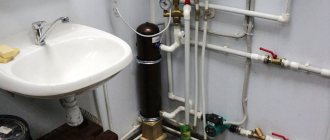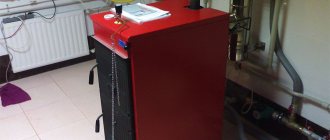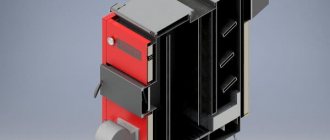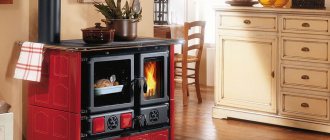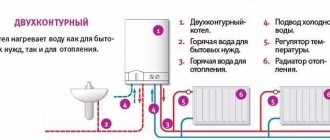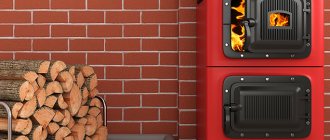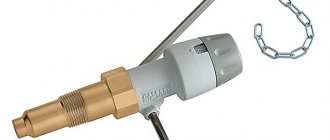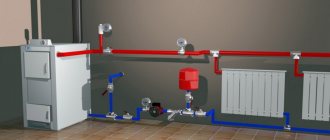Heating and hot water costs based on the consumption of energy carriers such as gas and electricity are growing annually. If residents of megacities in apartment buildings have little influence on the choice of fuel, then people living in low-rise or private housing can look for more acceptable options for themselves from available and traditional energy sources.
Until recently, the use of coal, peat, and especially firewood seemed archaic and a return to the stove primitive due to the complexity of automation and control of solid fuel combustion. Progress does not stand still; a large number of modern solid fuel boilers have appeared, equipped with perfect automation, interesting design, high technological and economic indicators. Pyrolysis solid fuel boilers are a striking example of such progress.
What are solid fuel pyrolysis boilers?
First of all, these are mostly single-circuit volatile boilers. The main and almost the only difference between pyrolysis boilers and classic solid fuel boilers is the presence of an additional gas combustion chamber. The process of separating and then burning high-energy gas from solid fuel makes it possible to obtain cheaper (in terms of the cost of 1 kW) thermal energy. And all this with high efficiency, longer combustion and reliable control without human intervention.
Design and principle of operation
The process of prolonged decomposition of organic compounds under the influence of high temperatures (up to 800 ° C), with a lack of oxygen for combustion, leads to the release of wood gas and the creation of charcoal, each of which is a high-energy fuel. A unit designed to separate these products and then burn them to produce hot water is called a pyrolysis solid fuel boiler.
The basic principle of operation of a gas generator boiler is to divide solid fuels into two fractions (coal and gas) in order to squeeze out all that they are capable of from their combustion. Their various devices have common features:
- solid fuel combustion chamber in the mode of maximum gas emission;
- gas combustion chamber;
- forced air supply control (fans or mechanical).
The design and principle of operation of a pyrolysis boiler with a bottom-mounted afterburner and forced draft.
In the combustion chamber, the loaded fuel burns in normal mode, the air supplied to the combustion zone brings the temperature in it to the point of abundant gas evolution and no more. The fuel burns gradually, turning into ash, heats the water jacket of the boiler and releases gas in a mode of limited oxygen supply.
The gas, due to the pressure difference (thrust), moves into the afterburning chamber, where it burns intensively with an abundant supply of oxygen, moving along the smoke tract. The high combustion temperature warms up the heat exchanger pipes and coolant.
The draft in the unit is created by a mechanical draft regulator that controls the blower door and the high chimney during autonomous operation. In modern boilers with a high level of automation, a blower fan is used to control the supply of oxygen to the combustion zone, and a fan-exhaust fan controls the draft of the burning gas through the heat exchanger.
Long-burning pyrolysis boilers
Separately, it is worth noting the category of long-lasting boilers. After accelerated heating of the coolant to a given temperature, the pyrolysis boiler switches to its maintenance mode. The flow of oxygen into the combustion chamber practically stops and the fuel burns out gradually, layer by layer, in smoldering mode. The duration of burning of one bookmark depends on the quality and quantity of loaded fuel.
One load of wood in a conventional pyrolysis boiler can burn up to 6-10 hours, coal - on average 8-15 hours, when in a conventional solid fuel boiler reloading is necessary after 3-6 hours. High-tech long-burning pyrolysis boilers are distinguished by a more capacious firebox and better combustion control, which allows them to operate with one load for up to 48 hours or even more.
Installation recommendations
It is necessary to install a long-burning pyrolysis solid fuel boiler while observing fire safety precautions. It is best to install the boiler in a non-residential area on a concrete base or metal sheet. The recommended distance to the walls of the room or furniture is at least 20 cm. The boiler room requires good ventilation in case of carbon monoxide leakage.
The following elements are used for connection:
- circulation pump;
- safety valve;
- expansion tank;
- emergency gravity circuit;
- boiler return temperature maintenance valve.
Watch a video on how to properly install a pyrolysis boiler with your own hands.
The connection to the heating system can be schematically represented as follows. Read the floor insulation calculator on our website.
How effective is pyrolysis technology from direct combustion?
In direct combustion boilers, the efficiency is rarely higher than 75-80%, and this is under ideal combustion conditions of high-quality fuel. For example, 1 kg of wood with a moisture content of 20% can produce 3.9 * 0.75 = 2.925 kW of thermal energy (specific calorific value of wood - 3.9 kW/kg). Coal with a moisture content of 10% produces 7.5 * 0.75 = 5.625 kW (specific calorific value of coal is 7.5 kW/kg).
With pyrolysis combustion technology, the efficiency today often reaches 92% and from the same fuel the unit will produce:
- 1 kg of wood – 3.9*0.92 = 3.588 kW (+22.7%);
- 1 kg of coal – 7.5*0.92 = 6.9 kW (+22.7%).
A significant difference shows how much heat is lost by emitting rather than burning associated gases (accordingly, with different differences in efficiency, the results will be different).
The use of effective combustion control during pyrolysis can significantly increase the operating time of the boiler in the mode of maintaining the coolant temperature, which further enhances the accumulation of thermal energy. The combustion temperature of pyrolysis gases is higher than with the classical method, so reaching the desired mode occurs much faster.
How and what kind of coal is best to heat a household solid fuel boiler
Safety precautions
When installing a homemade boiler, we follow the following important rules:
- to install the heating unit, you need to allocate a separate boiler room;
- The boiler room must be equipped with an effective ventilation system. The minimum area of the air duct opening is 100 cm2;
- the distance between the unit and any other surfaces and objects must be more than 20 cm;
- Before firing the boiler, we lay a steel sheet with a thickness of at least 3 mm on the floor;
- we install the boiler on a pre-equipped brick or concrete base;
- The chimney must be properly insulated. Without thermal insulation, the formation of condensation, soot and other troubles will be more intense. This will negatively affect the efficiency of the equipment and its service life.
Finally, the boiler efficiency is checked. To do this, just do a test load of fuel. If the smoke coming out does not have a carbon monoxide smell, then everything is in order with the efficiency of the boiler and it can be used to heat the house without any fear.
Reviews of domestic gas generator boilers: advantages and disadvantages
The world community's concern about the problem of environmental pollution has strengthened the position of pyrolysis boilers in the market of long-burning heating units. According to operating practice and reviews from owners, when this type of boiler operates correctly, a small amount of carbon dioxide and steam enters the atmosphere. When burning any organic fuel, such a unit emits a minimum of unburnt substances from the chimney without burning, without smoke, odor and color. The result is also manifested in emissions into the boiler room, for example, when reloading fuel, and especially in the contamination of the boiler itself and the frequency of its cleaning.
| Advantages | Flaws |
| Due to the afterburning of pyrolysis gases, the efficiency can reach 95%. | The cost of equipment is 1.5-2 times higher, although it pays off relatively quickly |
| An enlarged loading chamber allows you to work longer from one load (1.5-3 times) than with conventional units | High costs for fuel moisture treatment. It should not exceed 20%, otherwise the pyrolysis process will not take place |
| The fuel burns out with almost no residue and the design of the combustion chambers makes cleaning and maintenance less frequent and easier. | Most industrial and domestic units with high automation use blower fans and smoke exhausters, which makes them dependent on power supply |
| High temperatures require the construction of a heat exchanger made of heat-resistant steel, which makes it possible to heat the building faster | If the temperature of the coolant in the return pipe is low, the boiler may go out; it is necessary to add hot water through a three-way valve or bypass. |
| Emissions of combustion products are minimal | Overall dimensions and weight are significantly higher than those of other types of boilers |
| The units can operate on any organic fuel without significant modification, but with different efficiencies | At low loads (less than 50%) it is difficult to obtain stable combustion |
| High efficiency implies economical fuel consumption and reduces fuel costs | |
| A high level of automation of the boiler operation allows for less frequent monitoring of the combustion process |
Commissioning works
After the assembly of the pyrolysis boiler is completed, it is necessary to check the tightness of the welded joints. The water jacket is filled with water, then air is pumped into it, creating excess pressure. Poorly welded seams will make themselves felt by leaks. Now you can carry out tests, it is better to do this outside, supplying running water from a hose. If a safety group is installed on the unit, then you can fill the boiler tank with water and check its operation at a critical pressure of 2-2.5 Bar. The test order is as follows:
- Attach a temporary chimney, load fuel into the chamber and open the direct draft damper.
- Stop the flow of running water by providing a temporary tap.
- Ignite and start the pyrolysis boiler. As soon as the firewood flares up, the direct draft damper must be closed so that the pyrolysis process can begin.
- Open the secondary chamber door and make sure there is a flame. This requires adjustment of the pyrolysis boiler; you need to achieve an even and stable flame by opening or closing the air damper.
- Close the door and observe the readings of the thermometer and pressure gauge. In a closed water jacket, the process of vaporization can begin when the pressure reaches 1.5 Bar, at which time the temperature must be carefully monitored.
- High-quality welded pyrolysis heating boilers can withstand pressures of up to 3 Bar, but there is no need to set records. It is enough if the safety valve set to a pressure of 2 or 2.5 Bar begins to release steam, then you can open the tap and resume water circulation. The air supply damper must be closed for the fuel to begin to fade.
Be careful when carrying out such tests, there is a danger of scalding with boiling water due to negligence or if the water jacket ruptures
How to choose a pyrolysis boiler
The choice of a specific model and brand when finalizing a gas generator unit depends on the preferences and allocated budget for the purchase by the user. But for initial estimates, you should evaluate the characteristics described below.
Afterburner location
The location of the combustion chamber for pyrolysis gases does not change the principle of operation, but the design of the unit acquires its own characteristics.
The upper afterburning chamber, located above the fuel loading and combustion chamber, can do without forced ventilation. Boilers with this arrangement are more suitable for autonomous operation without electricity and fans. Gas rises into the combustion chamber due to natural pressure drop. However, some of the burning gases with unburned fuel residues escape into the atmosphere. The efficiency of such boilers is somewhat lower, however, the ash that has fallen into the loading chamber can be removed without problems during the next loading.
Most high-tech solid fuel pyrolysis boilers are produced with a lower afterburner chamber. Burning pyrolysis gases are forced by forced draft through the entire complex path of the heat exchanger and release all the thermal energy they are capable of. The efficiency of such boilers reaches 92%, and in some designs of famous brands even more. The inconvenience is that combustion waste from the fuel loading and combustion chamber falls into the lower chamber. This complicates the maintenance process.
Fuel
The choice of fuel for a solid fuel unit is determined by the most common type in the region. This will give an acceptable price and uninterrupted supply. For long-burning pyrolysis boilers, such characteristics of raw materials as combustion duration are important. They prefer fuel whose smoldering time is:
- coal – up to 15 hours;
- brown coal – up to 11 hours;
- firewood - up to 10 hours.
However, it is important to look at the information regarding the types of fuel that the boiler is capable of working with, because not all models are designed to burn coal. Other types of solid fuel (sawdust, wood chips, peat) may also not be intended by the manufacturer as fuel, but they burn out faster and require frequent refilling.
Pyrolysis as a process is very critical to the humidity of the raw material; if it is above 20%, a significant part of the energy will be spent on drying, the efficiency will be low and it will be problematic to recoup the significant costs of purchasing equipment. The best fuel option for most boilers is hardwood with a moisture content of 10%.
Natural or forced draft
Controlling the combustion process in a pyrolysis boiler requires adjusting the oxygen flow in the loading chamber or lower combustion chamber of pyrolysis gases, as well as moving the burning gas through several bends of a modern heat exchanger. To organize such draft, the height of the chimney becomes unrealistic. Therefore, high-tech boilers are equipped with blower fans, smoke exhausters and a variety of feedback sensors for analyzing the process by a computer that controls the entire heating system. This automation makes the equipment energy-dependent and expensive. The cost of such a unit is high, but high efficiency, economic efficiency and consumer comfort require such expenses.
A non-volatile pyrolysis boiler can have an upper gas combustion chamber. A mechanical draft regulator that regulates the supply of oxygen controls the ash flap, thereby prolonging the smoldering of the fuel in the loading chamber. Pyrolysis gas enters the upper chamber independently, due to the pressure difference between the chimney and the firebox. In it, it mixes with oxygen from the secondary air (second damper) and burns out. Most of the heat goes to heating the coolant, some through the chimney into the atmosphere. The process of setting up pyrolysis combustion requires very scrupulous compliance with the manufacturer’s instructions, but you can achieve real energy independence.
Boilers with a burning duration of one load of fuel up to 7 days
Are pellet boilers with automatic fuel supply worth the money?
Efficiency
The efficiency declared in the documents for a pyrolysis solid fuel boiler is the higher, the better. This means that operating costs will allow you to quickly recoup the cost of the equipment. However, the rated efficiency is determined by the manufacturer for ideal conditions, with a certain fuel, chimney, etc. According to my experience and operating instructions for pyrolysis boilers, the following conditions must be met:
- accurately perform the necessary boiler settings for efficient operation;
- The quality of the fuel in terms of humidity and ash content must correspond;
- the fuel chamber must be loaded to 100% volume;
- The placement of fuel in the firebox should also be carried out in accordance with the recommendations.
In general, in order for the actual efficiency not to differ from the declared one, many conditions must be met, but the situation is similar with classic solid fuel boilers. However, speaking about the declared efficiency, when choosing, I recommend starting from 88% or higher. Efficiency below 86-87% indicates an imperfect design and often does not justify the increased cost.
Minimum required power
An exact calculation of the minimum power when choosing a specific boiler is made by a heating engineer based on the standards and coefficients of SNiP 2.04.01-85.
In practice, in domestic conditions they often use the rule of 1 kW per 10 m2 of heated area and add + 20% reserve for single-circuit boilers.
For example, to heat a room with standard ceilings (2.7 m) with light or sufficient insulation of 180 m2, the minimum boiler power will be (180/10) * 1.2 = 21.6 kW. You need to choose a unit with the next higher rated power.
What fuel is suitable
The fuel moisture content should not exceed 25%, otherwise energy will be spent on water evaporation, the power will be lower than necessary, and water vapor will begin to dilute the released gases and interfere with combustion. As a result, the boiler will stop working.
Otherwise, the choice of fuel often depends on the model. There are devices that are exclusively wood-burning, and some units can work well on other types of combustible materials, such as brown or coal.
The most effective gas generator systems are those running on fuel with a high yield of volatile substances:
- firewood;
- pellets;
- wood waste;
- fuel briquettes;
- brown coal.
When choosing a material, you also need to focus on the duration of its combustion. To burn soft wood it will take 7 hours, compressed sawdust, peat and hard wood - 9-10 hours. The smoldering time for brown coal is limited to 10–11, and for black coal – 12–14 hours.
The greatest power will be provided by natural firewood with log lengths of 450–650 mm. In addition, the use of this type of fuel helps to increase the service life of equipment.
The best known manufacturers and models: characteristics and prices
The market for gas generator boilers is saturated with many types of imported and Russian-made equipment. Traditional leaders in the creation of high-tech heating systems based on pyrolysis units are German manufacturers. Their equipment meets the highest environmental requirements, the highest efficiency and economic efficiency. But the prices for German boiler units are appropriate.
The presence of Czech and Italian companies is noticeable, producing similar high-quality products and occupying the middle price segment of offers in the gas generator boiler market.
In recent years, the Russian production of boiler equipment has made significant progress towards the production of decent quality gas generator units for heating at a significantly lower (2-3 times) price for products that are close to imported ones in terms of characteristics and performance. Considering that it is better adapted to existing fuel and operational realities, purchasing it is interesting not only for a limited budget.
Burzhuy-K "Modern-12"
This series, combining energy independence and an affordable price, is one of the best among pyrolysis boilers for heating a private home. The interval between adding firewood is 12 hours, and coal is 15 hours. The boiler is efficient up to 50% fuel moisture content, although with a slight decrease in efficiency. The efficiency with fuel that meets the requirements reaches 92%, which is a very respectable figure, especially for the level of domestic manufacturers.
The boiler runs on any solid fuel; for natural draft they need a chimney with a height of at least 7 m (quite a lot, but realistic). The structure is fireproof, sheathed in steel sheets with basalt coating and does not require permits from supervisory authorities, weight - 220 kg. According to operating practice, it is considered absolutely problem-free, which is understandable, because the design is as simple as possible and non-volatile.
Efficiency and selection criteria for long-burning coal-fired boilers
Trayan TB-10-2KT
Gas-generating double-circuit boiler with a rated power of 10 kW, the control range allows a reduction of up to 40% of the nominal value. Non-volatile, with mechanical control. Efficiency depending on adjustments and fuel is 82-85%. The main feature, in addition to the DHW circuit, is the extremely compact dimensions - 450x890x730 mm (WxHxD). Supplied with a thermometer, pressure gauge and mechanical Honeywell damper regulator for air supply.
It is simple and safe to use; the period between loadings of dry fuel with proper regulation of the boiler operation reaches 10 hours. To maintain the coolant temperature at low loads, heating elements up to 3 kW can be connected (optional); a full set of volatile automation is also optionally available. Boiler weight 190 kg.
Cost: 43,000-53,000 rubles.
Buderus Logano S171-22W
It is included in the rating as one of the most high-tech boilers with a lower afterburning chamber for pyrolysis gases made in Germany. The main fuel is wood with a log length of up to 58 cm, which is extremely practical. Efficiency reaches 89%, equipped with the most modern automation systems: adjustable blower fan and smoke exhauster motors; control of heating system pumps; temperature sensors in rooms; control from mobile phone and PC.
The quality of heating system control allows you to save fuel and ensure high environmental safety. The large loading chamber ensures a burning duration of 3-4 hours and an average wood consumption of 6.2 kg/hour. Providing the highest level of user comfort while maintaining intuitive functionality also requires high service requirements. Overall dimensions of the unit are 1136x620x1019 mm, weight 362 kg. The only disadvantages are that they are intended for burning wood only, the heavy weight due to the heat exchanger made of 5 mm steel, and the high price.
Cost: 179,000-198,000 rubles.
Atmos DC 18S
Czech gas-generating single-circuit long-burning boiler with a built-in fan-smoke exhauster. The 20 kW model has a loading chamber of only 65 dm3, but the combustion duration of one load of firewood can reach 12 hours. The best fuel for it is logs up to 33 cm long and up to 15 cm in diameter, which, of course, is not so practical. But a well-functioning boiler allows you to save up to 40% of fuel per season, firewood consumption is 3.8 kg/hour, efficiency can reach 90%. The control is partially mechanical, but due to the fan and automation, the boiler requires connection to the electrical network. The heat exchanger is made of 6 mm alloy steel.
An important feature of such boilers is a built-in smoke exhauster; it eliminates smoke when reloading firewood, promotes rapid heating of the chimney and eliminates odors. Pyrolysis units of this type can be retrofitted with special pellet burners. Overall dimensions 590x1180x845 mm, weight 269 kg.
"Suvorov-M" K-10
Domestic pyrolysis single-circuit long-burning boiler with an open firebox (air flow is not forced) with a rated power of 10 kW, its control range is from 2.2 kW to 12 kW. Large loading firebox, one stack of logs burns for 10-14 hours, and fuel briquettes for up to 36 hours. The use of hardwood increases the burning time by 20-30%; with good quality sawdust briquettes, the smoldering time increases significantly. The length of the logs can be up to 45 cm, the full load of dry firewood is 14 kg, their consumption is 2.9 kg/hour.
The boiler uses any solid fuel. The humidity of the raw materials should not exceed 25% to achieve an efficiency of 92%. Non-volatile, it is possible to connect a hot water supply circuit and install heating elements. Overall dimensions 990x535x780 mm, weight 185 kg.
Cost: 62,000-64,000 rubles.
"Suvorov Ultra" K-15U
Long-burning mine gas generator boiler with a nominal power of 15 kW, its control range from 1.7 kW to 20 kW. The burning time of firewood is up to 65 hours, fuel briquettes are up to 120 hours. The 140 liter firebox can accommodate logs up to 40 cm (not so practical, but sufficient), and the loading weight is 46 kg. The humidity of firewood, at which the maximum efficiency of 94%-95.7% is achieved, should not exceed 25%. The height of the chimney, measured from the grate, must be at least 6 m - a completely standard requirement.
The shaft layout of the boiler with bottom combustion of fuel, innovative engineering solutions associated with increasing the length of a special three-turn gas path, made it possible to increase the burning time of firewood, and therefore squeeze the maximum possible out of it. Overall dimensions of the boiler are 1210x560x875 mm, weight 295 kg.
Cost: 93,000-96,000 rubles.
Analysis of diagrams, drawings and calculations
To better understand the operating principle of the device, it is recommended to study the diagram of a pyrolysis boiler.
Before starting work, it is recommended to carefully study the design diagram of the pyrolysis boiler in order to understand the principles of its operation and avoid mistakes
It reflects the position of such necessary elements as:
- air hole;
- the combustion chamber;
- smoke ducts;
- pipes for supplying and draining water;
- regulators;
- fan installation location, etc.
Since the pyrolysis boiler is a rather complex device, it is recommended to adhere to the drawing when manufacturing it. One of the most common device models, which is suitable for self-production, is presented below:
This drawing shows in detail the design of a pyrolysis boiler, which you can make yourself. It is recommended to strictly adhere to all dimensions specified by the developer
Typically, a 40 kW boiler is used for a private home. If this indicator needs to be increased or decreased, it is recommended to change the device parameters accordingly. The necessary data is presented in the table:
To make a pyrolysis boiler of suitable power with your own hands, you need to make elements of the appropriate size. The correct size ratio guarantees a successful result
A boiler with a power of 25-30 kW may be the best choice for a small house. Manufacturing a small unit will save both time and money.
Prices: summary table
| Model | power, kWt | Efficiency,% | Peculiarities | Cost, rub. |
| Burzhuy-K "Modern-12", Russia | 12 | 92 | Non-volatile, with mechanical control, the interval between adding firewood is 12 hours, coal is 15 hours. | 59 000-62 000 |
| Trayan TB-10-2KT, Russia | 10 | 85 | Non-volatile, dual-circuit, with mechanical control, the period between fuel additions is 10 hours, the ability to connect a 3 kW heating element. | 43 000-53 000 |
| Buderus Logano S171-22W, Germany, Bosch Thermotechnik GmbH | 22 | 89 | Energy-dependent, highly automated, environmentally friendly, loading period - 3-4 hours. | 179 000-198 000 |
| Atmos DC 18S, Czech Republic | 20 | 90 | Volatile, with built-in smoke exhauster, long burning, one load – up to 12 hours. | 127 000-159 000 |
| Suvorov-M" K-10, Russia | 12 | 92 | Non-volatile, long burning. The burning time of one coniferous bookmark is up to 14 hours, hard wood – up to 17 hours, fuel briquettes – up to 36 hours. | 62 000-64 000 |
| Suvorov Ultra" K-15U, Russia | 15 | 94 | Mine, long burning, firewood - up to 65 hours, fuel briquettes - up to 120 hours. | 93 000-96 000 |
The technology of converting solid fuel into heat and hot water has seriously advanced from stove heating. In terms of cost-effectiveness of use, abundance of innovative solutions, environmental safety and affordable comfort, pyrolysis boilers are quite competitive compared to gas and electric appliances, and the market provides a choice for every taste and budget.
BoilersPyrolysis boiler unitsSolid fuel boilers
About the pellet burner
A pellet burner is a special heating device that produces heat by burning pellets or fuel granules in a boiler. In some cases, these burners use unnecessary dry grain.
There are manual and automatic burners; in automatic burners, fuel is supplied to the combustion hopper using a special auger, and the entire process is controlled by sensors, due to which the device requires minimal control from the user. Pellet burners have found their use not only in everyday life, but also in industry. They are used for space heating, water heating and to meet a number of other needs.
Pellets, or fuel granules, are a special solid fuel that is obtained from wood or agricultural waste by pressing and granulating under high temperatures.
Pellets are an environmentally friendly type of fuel, since when they are burned, the same amount of carbon dioxide is released into the atmosphere as is formed during the natural decomposition of wood
In countries where agriculture and the woodworking industry occupy leading positions, the cost of pellet fuel is much lower than that of coal. The only exceptions are those regions in close proximity to which coal mining enterprises are located.
When burning pellets, hazardous fumes are not released, as happens when burning liquid fuel.
Technological process
Before starting calculations, it is advisable to decide on a suitable heater model:
- what functions it should perform (only heating or also as a home kitchen);
- what fuel is most available;
- intended installation location.
Large stoves allow you to heat spacious rooms. Metal units are mobile and can be easily transported from place to place. The brick kiln is always stationary.
If these issues are resolved, you can begin to make a pyrolysis oven with your own hands.
The body of a potbelly stove type can be made from scratch using high quality steel sheets. It is easier to make the furnace body in the form of a rectangle with double walls, filling the opening with sand or water (you will get a water circuit). Another option is to use an existing steel container such as a barrel or gas cylinder.
In the case of a brick building, you will need the skills of a masonry master.
In any case, you will have to make two combustion chambers. One is the combustion chamber, where solid fuel is processed; in the second, processed products are burned, coming into contact with air. Grate bars are installed between the chambers. It is advisable to make the chimney removable, so it is easier to clean.
The dimensions of the future installation depend on the required power. The main element is the combustion chamber. When calculating its volume, it is based on the combustion rate of the proposed fuel and its mass. The load factor is generally considered to be 0.63 (by which the mass of fuel is divided).
Suppose you need to create a metal furnace. You will need the following materials:
- steel sheets grade st. 20 4 mm thick (cutting is best left to specialists);
- steel corners with identical shelves 4x50 mm;
- steel reinforcement with a cross section of 8 mm;
- pipe with a diameter of 60 mm for the blower;
- 120 mm pipes for the chimney;
- one and a half dozen bricks.
You also need tools for the job:
- welding machine with a set of electrodes;
- grinder, drill;
- building levels, tape measure, pencil;
- hammer.
DIY assembly
When making a pellet burner with your own hands, it is important to pay special attention to the basket. Often, due to improper implementation, pellets can get stuck. In this case, the combustion process does not follow the required algorithm and the fire returns to the bunker
To eliminate this drawback, you need to look at the upper right part of the figure below. The slot through which the pellets will be supplied does not need to be made solid. It should have holes that are 2 mm smaller than the pellets themselves. It is also worth paying attention to the gap between the bottom of the basket and the back wall. It should be at least 6 mm, but 2 mm smaller than the size of the pellets. The unit where the pellet combustion chamber is separated from the pyrolysis gas combustion chamber must be made with continuous slits. If the burner is designed for a boiler with an area of 150 m2, then the height of the secondary air channels that pass under the bottom of the basket should be 30 mm
In this case, the combustion process does not follow the required algorithm and the fire returns to the bunker. To eliminate this drawback, you need to look at the upper right part of the figure below. The slot through which the pellets will be supplied does not need to be made solid. It should have holes that are 2 mm smaller than the pellets themselves. It is also worth paying attention to the gap between the bottom of the basket and the back wall. It should be at least 6 mm, but 2 mm smaller than the size of the pellets. The unit where the pellet combustion chamber is separated from the pyrolysis gas combustion chamber must be made with continuous slits. If the burner is designed for a boiler with an area of 150 m2, then the height of the secondary air channels that pass under the bottom of the basket should be 30 mm.
In addition to the basket, a scrupulous approach also requires a bunker in which the pellets will be stored. The problems begin with those pellet bins that are made by eye and according to a loose drawing. On the left in the diagram above are the dimensions and drawings of the hoppers that are used in Pelletrons. With a home area of 150 m2, one such bunker is enough for a day. At the bottom right in the same figure is a drawing and dimensions of the combustion chamber. The basis for them was the Pelletron 15 pellet burner. The corridor through which the secondary air will move is best done in the shape of the letter “L”. This is necessary for better mixing of secondary air with pyrolysis gases. This will increase the efficiency of the installation. The combustion chamber will require a special type of steel that can withstand high temperatures. At the same time, welding it at home can only be done with spot welding, since a conventional welding machine will have difficulty warming it up. You will need sheets with a minimum thickness of 2 mm. An interesting design of a pellet burner is shown in the video below.
